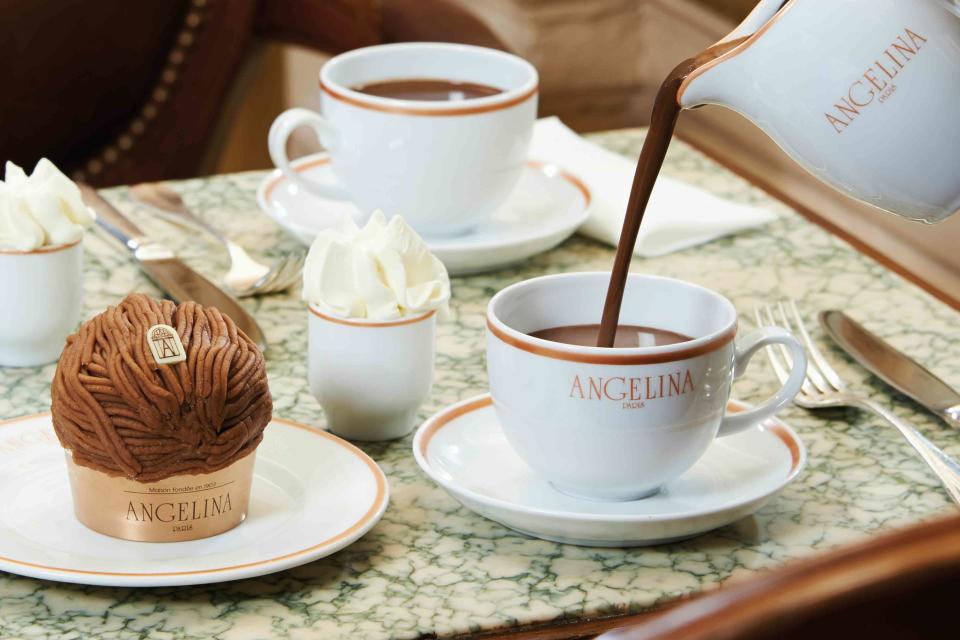In Paris, Hot Chocolate Isn't Just a Drink — It's a Ritual
Yes, the French dedicate an entire season to hot chocolate.

Angelina
It had been a hard week. The sheen of moving to Paris dimmed slightly as my son started his first week of moyenne (the French equivalent to Pre-K), and I spent those long, gray winter days worrying and hoping that someone would be nice to the new kid who didn’t speak their language. He made it through his first week with a smile and some new French vocabulary, so I treated him the only way I know how — through the sweet comfort of chocolate.
But not just any chocolate: A cup of thick and rich French chocolat chaud. This exquisite blend of butter, melted chocolate, and whole milk doesn’t resemble anything similar to the murky, watery hot chocolate we’re used to in America. Its silky liquid clings to the spoon when stirred, and when mixed with a dollop of freshly whipped chantilly cream, it takes on a quality that is best described as ethereal. It’s grounding yet uplifting; sweet but dark.
We squeezed into a little table at our neighborhood café, and I sat in awe as my son ordered flawlessly with the phrase we’d been practicing for months leading up to the move, “Je voudrais un chocolat chaud, s’il vous plaît” (i.e., “I’d like a hot chocolate, please”). I added an allongé to the order, feeling very proud for ordering my Americano coffee the French way, but as I glanced around, I noticed not a single cup of coffee in front of any of the actual French clientele. Everyone was drinking what my son had just ordered.
Related: We Tasted Every Instant Hot Chocolate We Could Find — Here Are the Best
I’d visited Paris many times before moving to the city, and had always noticed guests at local cafés sipping creamy cafés au lait and teeny tiny espressos. But this time, I had arrived during chocolat chaud season, and it wasn’t just kids sipping the saccharine drink. Serious-looking businessmen in suits doled out chantilly into their dainty tea cups while ladies licked smears of chocolate from their rouged lips and gossiped behind raised mugs. Yet, there I was, staring longingly from behind my sad, sugarless cup at my son’s drink as he out-Frenched me once again, dipping the tip of his croissant into the frothy foam the same way others around us had done..
Drinking hot chocolate in France is a ritual, not an indulgence, and it’s not just for kids. People will drink it early in the morning on occasion — after all, le petit déjeuner in France is a sweet affai — but the ritual really heats up in the afternoon. Between December and March, chocolat chaud serves a specific purpose and is traditionally sipped slowly during “le goûter,” the late afternoon break, as a way to sweeten a long day. As my French neighbor put it: “It’s how we add a sweet touch to these last dreary days of winter.” Although kids will partake in a cup if offered, chocolat chaud is the très chic way to “goûter” this time of year, and it’s mainly the 12-and-up crowd that sips instead of snacks (young kids prefer their chocolate in bar form, often sandwiched between a baguette).
Traditional French chocolat chaud is never powdered, and even the version served at our neighborhood park kiosk makes theirs with fresh whole milk and real melted chocolate. Restaurants take it a step further, blending the milk and melted chocolate with a homemade crème pâtissière, which is made by heating vanilla-pod-infused milk with butter, egg yolk, cornstarch, and just a hint of sugar. The mixture comes together on the stove, only removed once the liquid is thickened to a consistency just shy of a fondue.
Related: Legendary Paris Restaurants That Live Up to the Hype
Many cafés in Paris add their spin to the traditional recipe, which is always made with milk, not cream. The most famous is likely the chocolat chaud from Angelina, which is made with African cocoa from Niger, Ghana, and the Ivory Coast. It’s so loved in France that the company even bottles the recipe and sells it online and in many French grocery stores. True Parisians prefer the version from Carette, served in a miniature carafe alongside a silver coup filled brimming with freshly made chantilly, while trendy expats prefer the less-sweet versions at Partisan or Patisserie Viennoise.
Everyone in the city has a favorite — whether it’s Les Deux Margots, The Proust Bar, or any of the places listed above — but anyone who tells you there is a specific place to find the “best in the city” has missed the point entirely. Superlatives matter little when the entire point is the ritual itself. This season in France is one of slowing down, sitting down, and sipping on something that makes you happy in hopes that that bit of rich, satisfying sweetness might overshadow the bitterness of winter, and yes, maybe even the bitterness of a hard week.
For more Food & Wine news, make sure to sign up for our newsletter!
Read the original article on Food & Wine.

